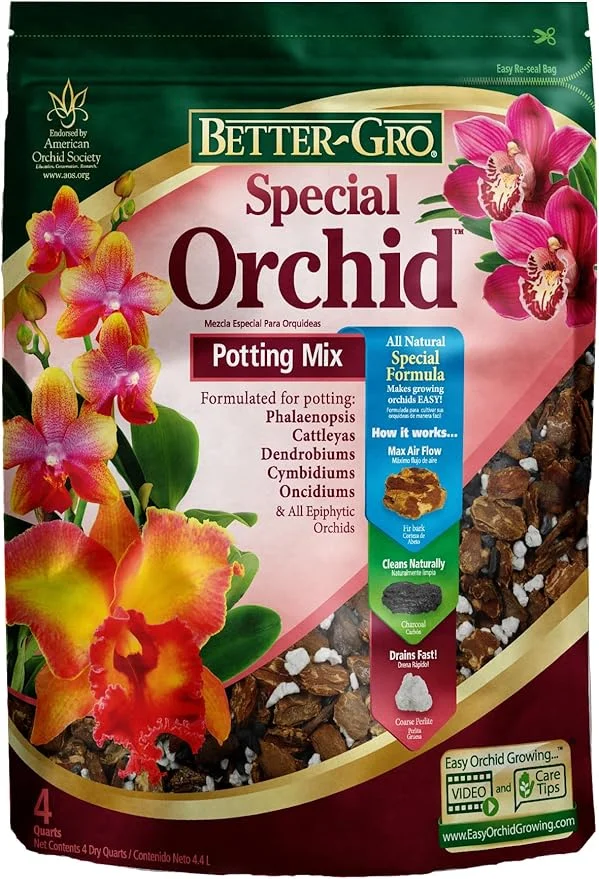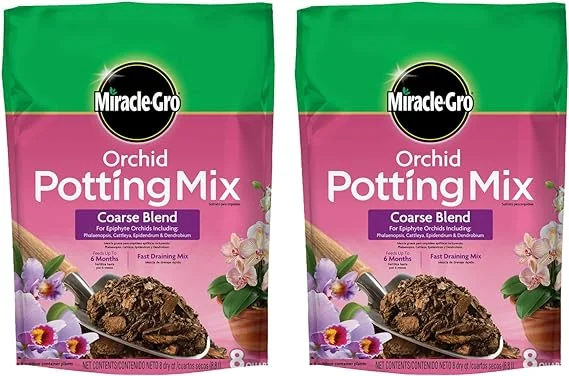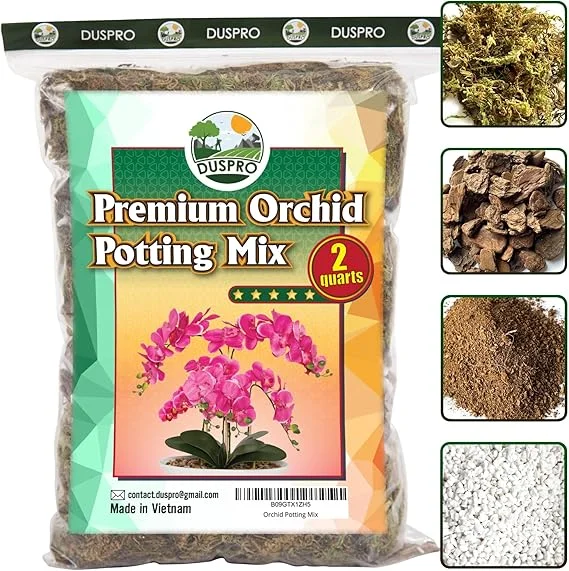How to Grow and Care for Nun Orchid (Phaius Orchid) Indoors
Some links in this post may be affiliate links
Nun Orchid (Phaius Orchid) grows best in bright indirect, warm and humid conditions and moderately moist, rich, well-drained soil coupled with regular feeding in the growing season.
Phaius Orchids also called Swamp Orchids or Nun's Hood Orchids are popular orchids with long-lasting and delicately fragrant flower whose colors range from brown to maroon, often with a white or pink lip.
Nun Orchids are evergreen, terrestrial herbs with thin underground rhizomes and crowded above ground and sometimes stem-like pseudobulbs. The leaves are several, pleated, stalked and emerge from the pseudobulb.
The Phaius Orchids were first formally described in 1790 by Joao de Loureiro (a Portuguese Jesuit missionary and botanist). The genus name Phaius is derived from the Greek word phaios meaning "dusky" or "brown" in reference to the brownish color of the flowers.
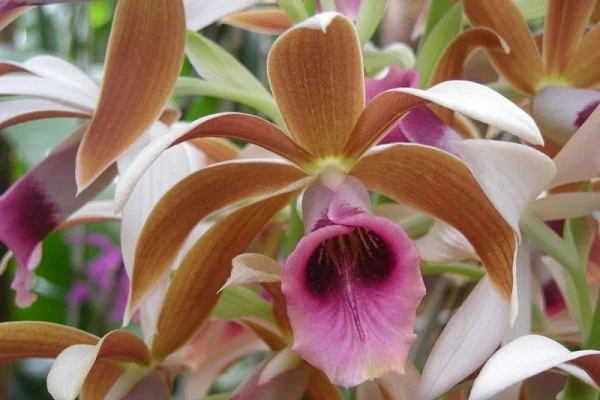
Botanical name: Phaius
Tribe: Collabieae
Common names: Nun Orchid, Swamp Orchid, Nun's Hood Orchid
Origin
Phaius Orchids are native to tropical parts of Africa, Asia, Southeast Asia, New Guinea, Australia and various islands of the Pacific and Indian Oceans. They are found growing on the humid, tropical forest floors.
Flower
The blooms in Nun's Hood Orchids are produced on tall spikes each bearing a cluster of 10-20 flowers. The flowers are long-lasting and delicately fragrant. The colors range from brown to maroon, often with a white or pink lip.
They are called Nun Orchids in reference to their curved upper sepal and petals that are white on the back side resembling a nun's cap.
Is Nun Orchid toxic?
Phaius Orchids are non-toxic to both humans and pets. They are safe for cats, dogs and other pets.
Where to Buy
If you are looking to add orchids to your collection, you may get them online from Etsy (Link to Etsy).
How do you care for Nun Orchid indoors?
To care for Nun Orchid indoors, provide bright indirect light (filtered light), average warmth of 15-290C, humidity of 60-70% and moderately moist, fertile, well-drained potting soil coupled with regular feeding during the growing season.
Phaius Orchid care requires regular pruning to keep it neat as well as encourage flowering. Repotting is needed only when they become pot-bound or the soil becomes completely broken down. Keep reading for more on these growing conditions and how to achieve them.
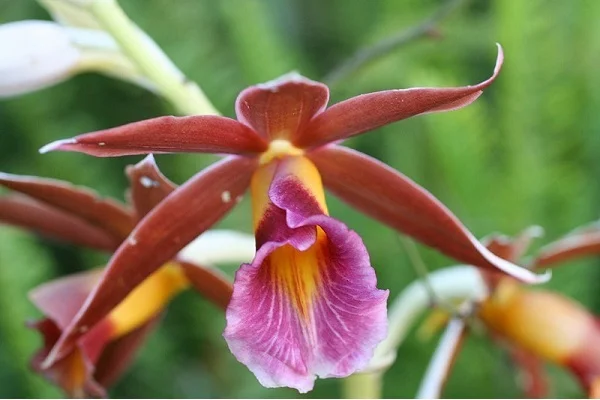
Light Requirements
Do Nun Orchids like full sun or shade?
Nun Orchids thrive in bright indirect light. Put it near a large, well-lit window. Keep it away from direct sunshine to avoid scorching of the leaves.
Where the light is not adequate, the orchid will not flower and will grow much slower. Therefore, use a full spectrum grow light to supplement the light.
Regularly rotate the pot to ensure that the orchid gets adequate light on all sides for a balanced growth.
Watering
How often should I water a Nun Orchid?
For lush growth and regular blooms, water your Nun Orchid thoroughly in spring and summer while allowing the top 2-3 inches of soil to dry out between waterings. Keep the soil moderately moist and avoid overwatering to prevent yellowing and rotting.
Cut down on watering in fall and winter as growth is minimal at this time to keep the soil slightly moist. Do not let the soil dry out completely to avoid wilting and drooping.
Use tepid (room temperature) water to avoid plant shock which can result in reduced growth and lack of blooms.
Phaius Orchids are sensitive to chlorine and other chemicals dissolved in water and can lead to brown leaf tips, therefore, water with chlorine-free water only.
Avoid soggy soil by ensuring that the soil is properly drained as it can cause the orchid to rot. Take care not to wet the foliage as it can lead to fungal diseases.
Provide a dry spell of about 4-6 weeks every 6 months to promote blooming. As in their natural habitat, Nun Orchids usually bloom at the end of the dry spells.
Nun's Hood Orchids unlike Phalaenopsis (Moth) Orchids are more tolerant of dry soil conditions due to the presence of pseudobulbs and their thick leaves, therefore, take care not to overwater.
Temperature and Humidity
Nun Orchids flourish in average warmth of 15-290C. Warmer days and cooler night temperatures are ideal for these orchids as the cool nights are essential to trigger flowering.
Keep the Swamp orchids away from drafts to avoid temperature flactuationss as they can adversely affect the growth of the orchids. Ensure that there is good air circulation as they cannot tolerate hot and stuffy conditions.
High humidity of 60-70% is essential for Nun's Hood Orchids to thrive. Set the pot on a wet pebble tray or use a humidifier to elevate humidity. Do not mist the orchids as it can lead to fungal disease infestations.
Fertilizer
What is the best fertilizer for Nun Orchids?
Feed Nun Orchids with an orchid's fertilizer in spring and summer as per the manufacturer's instructions. Withhold feeding in fall and winter as growth is minimal at this time and feeding can cause fertilizer burn.
Do not feed an orchid that is in flower. In feeding a Swamp Orchid, it is better to err on the side of underfeeding than overfeeding. Overfeeding may result in the loss of roots thus death of the orchid. It can also lead to vegetative growth at the expense of flower production.
Potting Mix
What is the best potting mix for Phaius Orchids?
Pot Phaius Orchids in loose, chunky, well-drained, orchids potting mix to avoid waterlogging which can cause rotting and death of the orchid.
Repotting
Nun Orchid blooms best when pot-bound. Repot only when growth begins to suffer; when the orchid has outgrown its pot and the new growth reaches out over the edge of the pot or when the soil has broken down completely.
Repot the orchid into a pot with proper drainage holes or slits as the roots need good air circulation. The pot should be only 1 size larger than the current one. Check out these ceramic orchid pots with a free slotted orchid pot liner on Amazon.
It is advisable to repot only when new growth begins, shortly after blooming is over; do not repot an orchid that is in flower as it shortens the blooming season. While repotting, shake off excess soil and trim off any dried and shrivelled pseudobulbs.
Pruning & Grooming
Pruning a Nun Orchid involves removal of dead and diseased leaves; cut the leaves at the base with a sharp, clean pair of pruning scissors or a knife. Make clean cuts and avoid unnecessary injuries.
When flowering is over, cut the flower stalk 1 inch above the 3rd node from the bottom to encourage more flowers.
Occasionally clean the leaves by damp-wiping with a soft cloth to discourage pest and disease infestations.
Phaius Orchid Propagation
Phaius Orchids propagation is done by rhizome division at the beginning of the growing season once flowering is over.
How to propagate Nun Orchids by rhizome division
- Gently split the rhizome into sections. Retain at least 3 shoots on each section.
- Seperate the roots attached to each section from the mother's root ball.
- Select a pot that is about 1-2 inches larger than the pseudobulb. Ascertain that the pot has enough drainage holes and slits to prevent rotting.
- Remove the old potting soil attached to the roots of the section and place each section in the center of the pot.
- Bury the roots of the section in the soil while ensuring that the bottom of the pseudobulb is level with the top of the soil.
- Stake each newly potted orchid to prevent it from toppling over.
- Position the set up in a warm, well-lit place away from direct sunlight until the sections have established their own roots.
- Water the new orchids lightly to enhance root development and once well established, begin routine care.
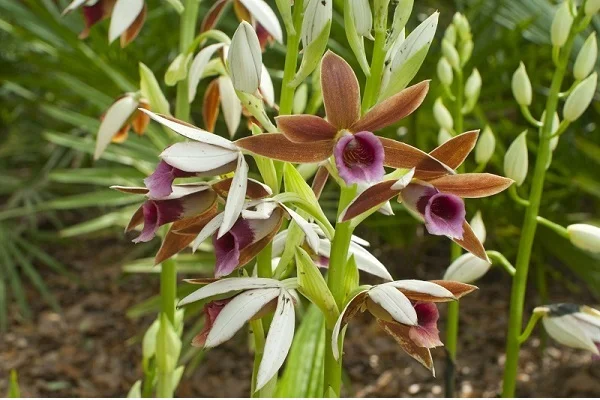
Phaius Orchid Problems & Remedies
Nun Orchid (Phaius Orchid) problems are yellow leaves, lack of blooms, brown leaf tips, drooping leaves, pests and diseases among others. Keep reading for more on these problems and their solutions.
Yellow leaves
Yellow leaves on Nun Orchid are caused by inconsistent watering, soggy soil, too little light, nutrients deficiency, and aging.
How to fix it
Inconsistent watering: Water when the top 2-3 inches of soil feel dry to the touch. Do not water on a schedule.
Soggy soil: Use a pot that has adequate drainage and soil that is well-draining.
Too little light: Move the orchid to a brighter spot or use a grow light if the natural light is not enough.
Nutrients deficiency: Feed with an orchid's fertilizer in spring and summer as directed by the manufacturer.
Aging: This is a natural process; as the orchid matures the lower leaves turn yellow, then brown and eventually fall off.
Lack of blooms
Lack of blooms on Nun Orchid is caused by too little light, overfeeding, dry air, drafts, and inconsistent watering.
How to fix it
Too little light: Place the orchid in a brighter spot where it will receive bright indirect light or instal grow lights if the natural light is not adequate.
Overfeeding: Too much fertilizer can result in vegetative growth at the expense of flowers production. Feed in spring and summer only and take care not to overfeed.
Dry air: To raise humidity use a wet pebble tray or a cool mist humidifier.
Drafts: Keep the orchid away from drafts coming from AC units, hot air vents, windy doors, drafty windows among others.
Inconsistent watering: Do not water on a schedule. Water when the top 2-3 inches of soil feel dry and never allow the soil to dry out completely.
Brown leaf tips
Brown leaf tips on Nun Orchid are due to hard water, underwatering, low humidity and temperature stress.
How to fix it
Hard water: Use chlorine-free water like rain water or filtered water to water the orchid.
Underwatering: Water when the top 2-3 inches of soil feel dry but never allow the soil to dry out completely.
Temperature stress: Keep the orchid away from drafts emanating from AC units, hot air vents, windy doors, drafty windows among others.
Drooping leaves
Drooping leaves on Nun Orchid are caused by underwatering, direct sunlight, extreme temperatures, and pests infestations.
How to fix it
Underwatering: Water when the top half of the soil dry, however, do not let the soilball dry out completely.
Direct sunlight: Keep the orchid away from direct sunshine or use a light curtain to filter the sunlight.
Extreme temperatures: Avoid drafts originating from stoves, hot surfaces, AC units, windy doors and windows, hot air vents and others.
Pests infestations: Regularly inspect the orchid for pests and take timely control measures.
Brown hard, dry leaf spots
Brown hard, dry leaf spots on Nun Orchid are due to exposure to direct sunshine. Place the orchid in a shadier spot or instal a sheer curtain to shield it from direct sunshine.
Dark-green leaves
Dark-green leaves on Nun Orchid indicate that the orchid is not getting enough light as the leaves of an orchid that is receiving the correct light should be light green. Position the orchid in a brighter spot or instal a grow light if the natural light is not sufficient.
Pests
Common pests of Nun Orchids are mealybugs, scale insects, slugs and snails infestation.
How to fix it
- Isolate the affected orchid to prevent spread to other plants.
- Treat the orchid with neem oil or insecticidal soap. Take care to follow the manufacturer's instructions.
- Regularly damp-wipe the leaves with a soft cloth to discourage the pests.
- Keep the orchid well pruned to minimize the hiding and breeding places for these pests.
Diseases
Nun Orchid is prone to the following diseases:
1. Powdery mildew which is prevalent in damp conditions coupled with poor air circulation. It presents a whitish-gray mold on the leaves.
How to fix it
- Remove the affected leaves and discard to reduce spread to other parts of the plant.
- Improve ventilation to ensure that there is good air circulation for the orchid.
- Do not mist the orchid and avoid wetting the foliage during watering.
2. Leaf spot disease which presents as brown soft spots on leaves. In a serious attack the spots can enlarge and merge, killing the whole leaf.
How to fix it
- Remove the affected leaves immediately to prevent further spread.
- Maintain a good air flow to minimize the disease occurence.
- Avoid wetting the foliage during watering. You water from the bottom.
You liked it? Share on social media.
Related Content
Amazon Associates Disclosure
Homeplantsguide.com is a participant in the Amazon Services LLC Associates Program, an affiliate advertising program designed to provide a means for sites to earn advertising fees by advertising and linking to amazon.com.
